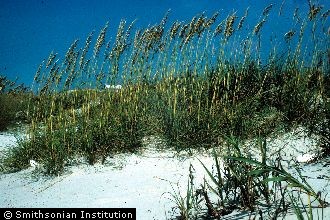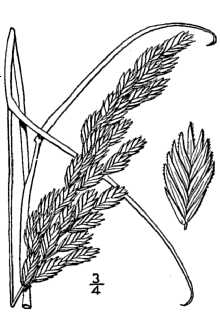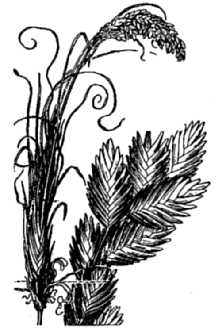Seaoats
Scientific Name: Uniola paniculata L.

| General Information | |
|---|---|
| Usda Symbol | UNPA |
| Group | Monocot |
| Life Cycle | Perennial |
| Growth Habits | Graminoid |
| Native Locations | UNPA |
Plant Guide
Uses
Sea oats is exceptionally tolerant of harsh conditions associated with coastal beach environments, such as, salt spray, short inundation of saltwater from storm surges, strong winds, xeric soil conditions, and rapid sand accretion. It is considered an excellent pioneering species because its ability to rapidly establish and colonize on fore-dunes and dune crests, and a climax species because of its ability to persist in these extreme coastal beach conditions. The attributes found in sea oats makes this species and excellent dune builder and sand stabilizer. Sea oats is an excellent conservation plant for dune building, dune enhancement, and sand stabilization on coastal beaches and barrier islands of the Atlantic, and Gulf of Mexico.
Status
This species is ranked on the Rare, Threatened, and Endangered Species state heritage conservation lists in Louisiana as a S2 - imperiled because of rarity (6 to 20 known extant populations) or because of some factors making if very vulnerable to extirpation, and a global ranking as a G5 - demonstrably secure globally although it may be quite rare in parts of its range, especially at the periphery (1000 + known extant populations). Please consult the PLANTS Web site and your State Department of Natural Resources for this plant’s current status (e.g. threatened or endangered species, state noxious status, and wetland indicator values).
Description
General: Sea oats is a native, warm-season, semi-tropical, rhizomatous perennial, C4 grass dominating many beach and dune environments. Culms are stout, erect 1-2 meters tall, nodes and internodes glabrous. Leaves are both basal and cauline with blades elongate to 60 cm long and 1.2 cm wide, both surfaces glabrous. The inflorescence is a large open panicle 8-15 cm long with flat yellowish spikelets, 10-20 flowered. Seed heads become a yellow-brown, straw color in late summer and into the fall. Distribution: Sea oats occurs along the U.S. coast and barrier islands from Virginia through Florida, the Gulf coast, and south to Mexico. However, it is uncommon in Louisiana west of the Mississippi River delta over to Texas. Habitat: Sea oats is typically found on loose sands of upper beaches, and the more exposed and accreting areas of dunes such as foredunes and dune crests. It is one of the few species that are able to establish and grow in this dynamic beach zone. Sea oats thrives and is actually stimulated where sand is actively accumulating. It is highly tolerant of xeric conditions, but sea oats does not tolerate water logging of roots, which will stress or kill plants within a few days. There are also beneficial microorganisms associated with the roots of sea oats. Vesicular-arbuscular mycorrhizal fungi are reported to increase the surface area of roots facilitating nutrient absorption and improving nutrition of sea oats communities.
Adaptation
Sea oats is an excellent pioneering species on upper beaches, fore-dunes, and dune crests, where loose sands accumulate. If is tolerant of salt spray, short periods of inundation by saltwater, rapid sand burial, and it is very drought tolerant. The extensive system of rhizomes and roots binds and holds blowing sands.
Establishment
Sea oats are generally established using vegetative propagules. Freshly dug bare-root plant divisions can be used effectively. Container grown plant materials have been proven to be more reliable in establishing stands. Propagation methods from plant division to micropropagation techniques are used. Generally, no site preparation is needed when planting vegetative plant materials. Beach plantings are established by planting propagules on 2 to 5 feet centers. Spacing is dependent on site conditions, erosion potential, and desired outcome of the planting. Sea oats is relatively slow to establish, so planting faster growing companion species, such as, bitter panicum or other desirable pioneering species is recommended. Generally, container grown plant materials can be planted year around, however, better results are achieved by planting mid-winter to early spring. Bare-root propagules should be planted November through March. Though sea oats are drought tolerant always consider site moisture conditions before planting. Since sea oats growing season varies considerably by geographic location, consult with local professionals when planning sea oats plantings.
Management
Restrict traffic during establishment. Sea oats can be effectively established and grow on low fertility soils without fertilization, however, if fertilization is desired for establishment purposes, apply 3.5-4.5 actual N per and 1.0- 1.5 pounds actual P per 1,000 square feet. Or place a slow release tablet with each plant when planting.
Pests and Potential Problems
There are no known serious pests associated with sea oats, , Use soil moisture sensors to measure the soil moisture of Seaoats.
Environmental Concerns
Concerns
Concerns
There are no environmental concerns associated with sea oats. It is highly desirable and beneficial native species. Cultivars, Improved, and Selected Materials (and area of origin) The USDA NRCS Plant Materials Centers have one released one variety: Caminada Germplasm sea oats is a pre-varietal release from the Golden Meadow Plant Materials Center, Galliano, Louisiana, selected to provide a plant for dune building, enhancement, and sand stabilization on coastal beaches and barrier islands of the Gulf of Mexico. Contact your local Natural Resources
Conservation
Service office for more information. Look in the phone book under ”United States Government”. The Natural Resources Conservation Service will be listed under the subheading “Department of Agriculture.”
References
Duncan, W.H. and M.B. Duncan. 1987. The Smithsonian guide to seaside plants of the Gulf and Atlantic coasts. Smithsonian Institution Press. Washington, D.C. 409 pp. Hester, M.W., and I.A. Mendelssohn. 1989. Water relations and growth response of Uniola paniculata (sea oats) to soil moisture and water-table depth. Oecologia. 78(3):298-296. Mendelssohn, I.A., M.W. Hester, F.J. Monteferrante, and F. Talbot. 1991. Experimental dune building and vegetative stabilization in a sand-deficient barrier island, setting on the Louisiana coast, USA. Journal of Coastal Research. 7 (1): 137-149. Radford, A.E., H.E. Ahles, & C.R. Bell. 1976. Manual of the vascular flora of the Carolinas. University of North Carolina Press. Chapel Hill. 1183 pp. Sylvia, D.M. 1986. Spatial and temporal distribution of vesicular-arbuscular mycorrhizal fungi associated with Uniola paniculata in Florida foredunes Mycologia 78 (5): 728-734. USDA, NRCS. 2006. The PLANTS database (http://plants.usda.gov, 27 December, 2006). National Plant Data Center, Baton Rouge, LA 70874-4490 USA. USDA, SCS. 1984. Plants for coastal dunes of the Gulf and South Atlantic coasts and Puerto Rico. Agricultural Bulletin 460. U.S. GPO: 1984—445-394. 41 pp.
Fact Sheet
Uses
Landscaping: Sea Oats is an attractive and important plant of the coastal community. Seed heads from this plant are sometimes used in floral arrangements. However, it should be noted that this species is protected in some states due to the vital role it plays in shoreline stabilization. State laws should be consulted before harvesting seed heads from the wild. Sea Oats is very valuable as a dune builder and stabilizer. Forage: Sea Oats is reported to have high palatability to browsing animals and moderate palatability to grazing animals. However, due to the location of its habitat, protected status, and low protein content, it has no value as a forage plant.
Status
Please consult the PLANTS Web site and your State Department of Natural Resources for this plant’s current status (e.g. threatened or endangered species, state noxious status, and wetland indicator values).
Description and Adaptation
Adaptation
Adaptation
Sea oats is a long lived, slow growing, warm season, perennial grass commonly associated with the upper dunes along beach fronts. It grows erect to approximately 6 feet in height at maturity, and has leaves that can grow to 24 inches in length. The leaves are narrow, less than 1 inch in width, and taper towards their ends. The ends of the leaves are often brown and curled in appearance. It produces a large seed head, or panicle, during the summer. The panicles are made up of many flat spikelets containing seed. The panicle turns from green to straw colored in late summer as the plant matures. The stem of the plant has bulges, or nodes, near the soil surface. These will often root down and anchor to the soil surface as wind born sediment accumulates around the plant. Sea oats is also rhizomatous. These rhizomes have a scale-like appearance when young, and can be seen as pale yellow, sharp, stiff, protrusions near the base of the plant. Sea oats is very drought tolerant. This species produces a massive root system, and will tolerate salt spray and brief inundation with salt water. It prefers full sun, and thrives in areas with blowing sand, such as dunes along the upper beach front. Burial of the plant’s base by blowing sand actually stimulates plant growth and helps the plant spread via rhizomes and tacking down at the stem nodes. It prefers coarse sediments, but will tolerate medium grained sediments. It will not tolerate fine grained sediments, and has a difficult time surviving in lower, wetter portions of the beach area. Though it is capable of surviving brief inundations of salt water, it will not tolerate water logging. Distribution: Sea oats can be found on beach fronts and barrier islands along the eastern seaboard of the United States from Virginia to Florida. Their range extends along the coast line of the Gulf States, south into portions of Mexico. It can also be found in the Bahamas and portions of Cuba.
Establishment
Sea oats is not a prolific seed producer, It produces large panicles with numerous spikelets, However, very few seed are actually produced, Seed is viable and will grow readily in greenhouse conditions, However, there are no sources of commercial seed available, Sea oats is predominantly established from containerized material and vegetative propagules, This species is rhizomatous and can be expanded by splitting larger plants into smaller propagules, Sea oats is relatively slow growing and will require time to recover from the shock of being split into smaller units and transplanting, It responds well to fertilization, but requires little to no nutrient input in field situations, Plantings on 2-5 foot centers have proven to be very effective, Due to the harsh environment this species inhabits, there is little competition from other plants, Site prep work is usually not needed, Plantings in early spring or fall produce the least amount of stress by allowing establishment time before the harshest portions of the year arrive, Use soil moisture sensors to measure the soil moisture of Seaoats., Though this species is very drought tolerant, plantings should be timed when adequate moisture is present, This will help reduce the shock associated with transplanting,
Management
Once established, Sea oats require very little management. Traffic into newly planted areas should be limited until the plants have become successfully established. A slow release fertilizer pellet is beneficial during early establishment. However, routine fertilization is not required.
Pests and Potential Problems
There are no known pests or potential problems associated with this species.
Environmental Concerns
Sea oats is an extremely valuable plant for coast line and barrier island protect. Its massive root system is capable of holding soil and sand in place during extreme weather events such as hurricanes and tropical storms. This plant’s habitat puts it at the forefront of shoreline protection. It is also capable of catching blowing sand and building dunes. It is very important to natural and artificial dune stabilization throughout much of its range. Cultivars, Improved, and Selected Materials (and area of origin) Caminada Germplasm is a pre-varietal release from the Golden Meadow Plant Material Center, Galliano, Louisiana Prepared By: R. Alan Shadow, Soil Conservationist, East Texas Plant Material Center, Nacogdoches, TX Species Coordinator:
Plant Traits
Growth Requirements
| Temperature, Minimum (°F) | 7 |
|---|---|
| Adapted to Coarse Textured Soils | Yes |
| Adapted to Fine Textured Soils | No |
| Adapted to Medium Textured Soils | Yes |
| Anaerobic Tolerance | Medium |
| CaCO3 Tolerance | Medium |
| Cold Stratification Required | Yes |
| Drought Tolerance | High |
| Fertility Requirement | Medium |
| Fire Tolerance | Medium |
| Frost Free Days, Minimum | 180 |
| Hedge Tolerance | None |
| Moisture Use | Low |
| pH, Maximum | 7.5 |
| pH, Minimum | 6.0 |
| Planting Density per Acre, Maxim | 19000 |
| Planting Density per Acre, Minim | 4840 |
| Precipitation, Maximum | 65 |
| Precipitation, Minimum | 35 |
| Root Depth, Minimum (inches) | 20 |
| Salinity Tolerance | Medium |
| Shade Tolerance | Intolerant |
Morphology/Physiology
| After Harvest Regrowth Rate | Slow |
|---|---|
| Toxicity | None |
| Resprout Ability | No |
| Shape and Orientation | Erect |
| Active Growth Period | Spring and Summer |
| Bloat | None |
| C:N Ratio | High |
| Coppice Potential | No |
| Fall Conspicuous | Yes |
| Fire Resistant | No |
| Flower Conspicuous | No |
| Foliage Color | Green |
| Foliage Porosity Summer | Porous |
| Foliage Porosity Winter | Porous |
| Fruit/Seed Color | Brown |
| Nitrogen Fixation | None |
| Low Growing Grass | Yes |
| Lifespan | Long |
| Leaf Retention | No |
| Known Allelopath | No |
| Height, Mature (feet) | 6.0 |
| Growth Rate | Slow |
| Growth Form | Rhizomatous |
| Fruit/Seed Conspicuous | Yes |
| Foliage Texture | Medium |
Reproduction
| Vegetative Spread Rate | Moderate |
|---|---|
| Small Grain | No |
| Seedling Vigor | Low |
| Seed Spread Rate | Slow |
| Seed per Pound | 4500 |
| Fruit/Seed Persistence | Yes |
| Propagated by Tubers | No |
| Propagated by Sprigs | Yes |
| Propagated by Sod | No |
| Propagated by Seed | No |
| Propagated by Corm | No |
| Propagated by Container | Yes |
| Propagated by Bulb | No |
| Propagated by Bare Root | No |
| Fruit/Seed Period End | Fall |
| Fruit/Seed Period Begin | Summer |
| Fruit/Seed Abundance | Low |
| Commercial Availability | Routinely Available |
| Bloom Period | Early Summer |
| Propagated by Cuttings | No |
Suitability/Use
| Veneer Product | No |
|---|---|
| Pulpwood Product | No |
| Protein Potential | Low |
| Post Product | No |
| Palatable Human | No |
| Palatable Graze Animal | Medium |
| Palatable Browse Animal | High |
| Nursery Stock Product | Yes |
| Naval Store Product | No |
| Lumber Product | No |
| Fodder Product | No |
| Christmas Tree Product | No |
| Berry/Nut/Seed Product | No |


